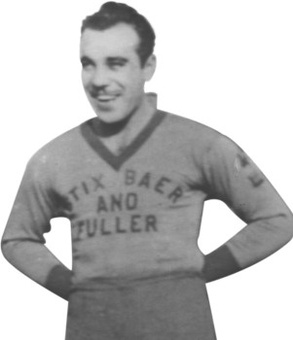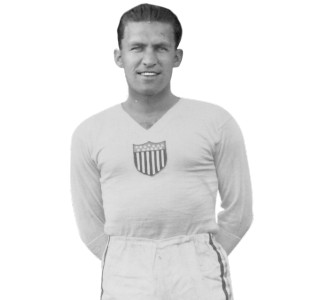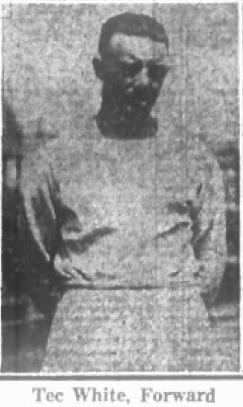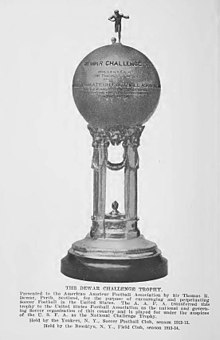
Bertrand "Bert" Arthur Patenaude was an American soccer player who played as a forward. Although it was formerly disputed, he is officially credited by FIFA as the scorer of the first hat-trick in World Cup history. He is a member of the United States Soccer Hall of Fame.

Adelino William Gonsalves was an American soccer player, sometimes described as the "Babe Ruth of American Soccer". He spent over 25 years playing in various American professional leagues and was a member of the U.S. squad at the FIFA World Cup in 1930 and 1934. He is a member of the National Soccer Hall of Fame.
Fall River Football Club, was the name used by a United States soccer clubs, based in Fall River, Massachusetts. They played in the American Soccer League during the 1931 and 1932 season. The name is often used and is not to be confused with the Fall River F.C. team owned by Sam Mark.
Fall River F.C. was an American soccer club based in Fall River, Massachusetts. During the 1920s and early 1930s they were one of the most successful soccer clubs in the United States, winning the American Soccer League on six occasions. They also won the National Challenge Cup four times. In 1924 they won the first ASL / Challenge Cup double and were subsequently the American soccer champions three times in succession. Between 1928 and 1930 they won a further three titles in a row. In 1930 they completed a treble, winning the ASL title, the Challenge Cup and the Lewis Cup. The same year they also toured Central Europe.
New Bedford Whalers was the name of three American soccer teams based in New Bedford, Massachusetts. The first Whalers played in the Southern New England Soccer League between 1914 and 1918. The second Whalers played in the American Soccer League between 1924 and 1931 before merging into Fall River F.C. The third Whalers were then formed when Fall River merged with New York Yankees. They played in the ASL between 1931 and 1932.
New York Giants was a name used by three different New York City soccer teams. Two of these teams were associated with the New York Giants baseball franchise. The first team that used the name played in the American League of Professional Football in 1894. The second team played in the American Soccer League between 1923 and 1930 while the third team played in the same league between 1930 and 1932.

Werner "Scotty" Nilsen was a former soccer player who played as a forward. He is one of the highest scoring players in United States soccer history, scoring 131 goals in 239 games with the Boston Soccer Club. He won five consecutive National Challenge Cups during his career, and four doubles. Born in Norway, he earned two caps with the United States national team in 1934. He is a member of the National Soccer Hall of Fame.
New York Yankees were a New York soccer team that played briefly in the American Soccer League. They were formed following the merger of Fall River F.C. and New York Soccer Club. Although the Yankees survived only a short time, they beat Celtic in a prestige friendly and effectively won the 1931 National Challenge Cup. However, due to complications over the merger their moment of glory was credited to Fall River F.C.

Alexander McNab was a Scottish-American soccer player and coach. He began his career in Scotland before moving to the United States. In the US, he won six consecutive National Challenge Cups with teams from both the American Soccer League and St. Louis Soccer League. He was inducted into the National Soccer Hall of Fame in 2005.

William McPherson was a Scottish-American soccer wing half. He began his career in Scotland before moving to the American Soccer League. He also spent time in the St. Louis Soccer League, winning a total of five league titles and seven National Challenge Cups during his career.

John Anthony Reder was a Polish-American sportsman who, during the 1930s, played soccer with Fall River F.C. and the New Bedford Whalers and baseball for the Boston Red Sox. In soccer, he played as a goalkeeper and won three American Soccer League titles and two National Challenge Cup titles. In baseball, he played as a first baseman for the Boston Red Sox, and was voted Most Valuable Player of the New York–Penn League while playing for the Williamsport Grays. Together with Moe Drabowsky, Nap Kloza and Henry Peploski, Reder is one of only four Major League Baseball players to be born in Poland.
Mark's Stadium is a former soccer stadium located in North Tiverton, Rhode Island. During the 1920s and early 1930s it was the home of Fall River F.C., one of the era’s most successful soccer teams. It is one of the earliest examples of a soccer-specific stadium in the United States. After the demise of the 'Marksmen', the stadium was used as a home ground by other local teams, most notably Fall River F.C. (1932) and Ponta Delgada S.C.
Samuel Mark was an American soccer club owner. During the 1920s and early 1930s he was the owner of Fall River F.C., one of the era's most successful teams. Mark's continued to own the team after it relocated and became the New York Yankees and then New Bedford Whalers. He also briefly owned Boston Soccer Club. He had played guard for the Massachusetts American Legion basketball team.

James White, also known as Jimmy White or Tec White, is a Scottish former footballer who spent most of his career playing for Fall River F.C. in the American Soccer League. He was born in Airdrie, North Lanarkshire, Scotland.
Frank McKenna was a Scottish football wing forward who began his career in Scotland before playing eight seasons in the American Soccer League.

The 1933 National Challenge Cup was the annual open cup held by the United States Football Association now known as the Lamar Hunt U.S. Open Cup. As in 1931, the ASL teams played a round robin format instead of direct knockout games. The five New York teams formed the Metropolitan group. The New England group included the three remaining ASL teams along with Victoria Mills of the Southern New England Association who qualified by defeating Fairlawn Rovers. The Round Robin was somewhat unpopular because of the methods used. Despite a league setup, games tied at the end of regulation were to go into overtime. In the event of a tie in the standings, goal average was used to break the tie. A slight controversy ensued when a game between Boston and Fall River was called at the 78th minute with the score 0-0. Fall River later forfeited the replay leaving Boston tied for first with Pawtucket. The Rangers advanced on better goal average leaving Boston unable to make up the difference in a replay with Fall River or a playoff with Pawtucket. In the West it was business as usual with the standard knockout procedure and the Stix of St. Louis making their second of what would be six consecutive trips to the national final. Other highlights include Bert Patenaude's five goal performance against Fairhill in the First German Club's first round match on January 14.
Statistics of American Soccer League in season 1930.
Statistics of American Soccer League in season 1931.
Clem Cuthbert was a Scottish-American soccer player who spent his career in the Chicago leagues.
The American Soccer League, established in 1921, was the first of four different professional soccer sports leagues in the United States to use the ASL name. It was formed by the merger of teams from the National Association Football League and the Southern New England Soccer League. For several years the ASL's popularity rivaled the popularity of the National Football League. Disputes with the United States Football Association and FIFA, as well as the onset of the Great Depression, led to the league's collapse in spring 1933.








